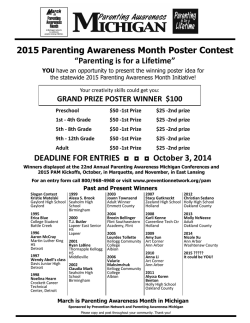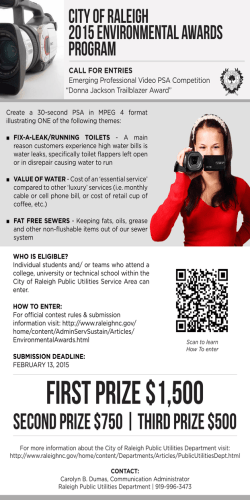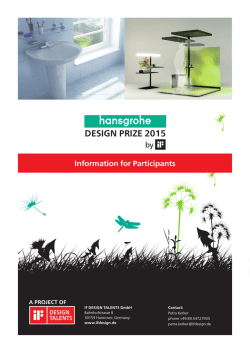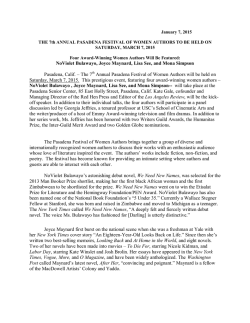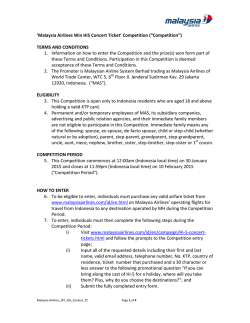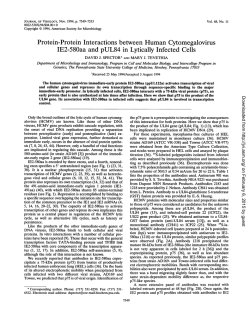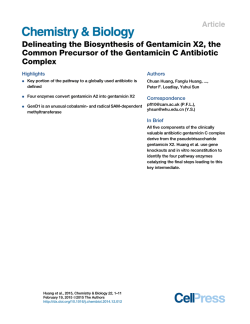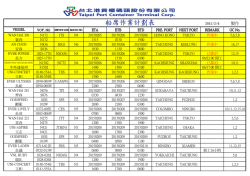
2015 Japan Prize News No.53
Fields Eligible for the 2016 Japan Prize Nominations and Selection Process ■ Every November, the Field Selection Committee of The Japan Prize Foundation designates and announces two fields in which the Japan Prize will be awarded two years hence. At the same time, the Foundation calls for over 13,000 nominators, strictly comprised of prominent scientists and researchers from around the world invited by the Foundation, to nominate the candidates through the web by JPNS (Japan Prize Nomination System). The deadline for nominations is the end of February of the following year. ■ For each field, a Selection Subcommittee conducts a rigorous evaluation of the candidates’ academic achievements. The conclusions are then forwarded to the Selection Committee, which conducts evaluations of candidates’ achievements from a wider perspective, including contributions to the progress of science and technology, and significant advancement towards the cause of world peace and prosperity, and finally the selected candidates are recommended for the Prize. ■ The recommendations are then sent to the Foundation’s Board of Directors, which makes the final decision on the recipients. ■ The nomination and selection process takes almost one year from the time that the fields are decided. Every January, the winners of that year’s Japan Prize are announced. The Presentation Ceremony is held in April in Tokyo. November, 2013 Determine the fields eligible for the 2015 Japan Prize Resources, Energy and Social Infrastructure End February, 2014 January, 2015 April, 2015 Selection Committee Invite the nominations Closing of the nominations Selection Subcommittee for Resources, Energy and Social Infrastructure Announce the Laureates of the 2015 Japan Prize Board of Directors The 2015 Japan Prize Presentation Ceremony Selection Subcommittee for Medical Science and Medicinal Science Medical Science and Medicinal Science Kunio Iwatsuki Chairman Vice Chairman Professor Emeritus, The University of Tokyo Hiroshi Komiyama Ryozo Nagai Yoshio Karita Chairman of the Institute, Mitsubishi Research Institute, Inc. President Emeritus, The University of Tokyo President, Jichi Medical University Director, The Japan Prize Foundation Masafumi Maeda Executive Vice President, Professor, The University of Tokyo Hideo Miyahara Professor Emeritus, Osaka University Takehiko Sasazuki University Professor, Institute for Advanced Study, Kyushu University President Emeritus, National Center for Global Health and Medicine Selection Subcommittee for the “ Resources, Energy and Social Infrastructure” field Member Kazunari Domen Chairman Deputy Chairman Makoto Misono Takashi Ibusuki Professor Emeritus, The University of Tokyo Chief Advisor Japan Environmental Management Association for Industry Professor, Graduate School of Environmental Studies Tohoku University Yoshitsugu Hayashi Shinichiro Ohgaki Shunsuke Ikeda Professor Emeritus, Tokyo Institute of Technology Mikiko Ishikawa Professor, Faculty of Science and Engineering, Chuo University Masayuki Kamimoto Assistant to the President, Hirosaki University Achievement eligible: The 2016 Japan Prize in the fields of “Materials and Production” will be awarded to individuals who have made significant contributions to society by achieving momentous scientific and technological breakthroughs that improve the quality and safety of people’s lives while ensuring the sustainability of society by designing and developing materials with new functions, or by advancing the technologies for industrial design, production and operation, that will create new products, services and industries. Area of Life Science, Agriculture and Medicine Biological Production and Biological Environment Background and rationale: Yukiko Gotoh Chairman Deputy Chairman Takehiko Sasazuki Aikichi Iwamoto University Professor, Institute for Advanced Study, Kyushu University President Emeritus, National Center for Global Health and Medicine Professor, The Institute of Medical Science The University of Tokyo Professor, Graduate School of Pharmaceutical Sciences, The University of Tokyo Hiroshi Honda Professor, Graduate School of Medical Sciences, Kyushu University Hidenori Ichijo Professor, Graduate School of Pharmaceutical Sciences The University of Tokyo Suminori Kono President, National Institute of Health and Nutrition Member Kazuhito Hashimoto Professor, Department of Applied Chemistry, Graduate School of Engineering, The University of Tokyo President, Japan Water Research Center Keiko Sasaki Professor, Faculty of Engineering, Kyushu University Takashi Tatsumi Executive Vice President for Research Tokyo Institute of Technology Akira Yabe Chairman Vice Chairman Katsuhiko Shirai Kohei Miyazono Chairperson, The Foundation for the Open University of Japan Professor, Department of Molecular Pathology, Graduate School of Medicine, The University of Tokyo Vice President, National Institute of Advanced Industrial Science and Technology Toshinori Nakayama Professor, Graduate School of Medicine, Chiba University Yasuharu Nishimura Professor, Kyoto University Kokoro Research Center Former Director, TDK Corporation Tohru Nakashizuka Nobuhide Kasagi Noriko Osumi Tsutomu Kimura Masakatsu Shibasaki Hiroshi Kuwahara Atsuko Tsuji Director General, National Museum of Nature and Science Professor, Department of Environmental Life Sciences, Graduate School of Life Sciences, Tohoku University Professor Emeritus, The University of Tokyo Principal Fellow, Japan Science and Technology Agency Advisor to Ministry of Education, Culture, Sports, Science and Technology Toru Nakano Kenichi Mori Yoshihiro Hayashi Senior Corporate Advisor, Hitachi Maxell, Ltd. Professor, Medical School Dean, Graduate School of Frontier Biosciences, Osaka University Director, Center for Neuroscience, Tohoku University School of Medicine Chairman of Board of Directors Microbial Chemistry Research Foundation Director, Institute of Microbial Chemistry Staff Writer, Op-Ed Section, The Asahi Shimbun ( alphabetical order, titles as of November, 2014) Schedule (2016-2018) Keiya Ozawa The fields eligible for the Japan Prize (2016 to 2018) have been decided for the two research areas, respectively. These fields rotate every three years, basically. Every year the Fields Selection Committee announces the eligible field for the next three years. Sumio Sugano Area of Physics, Chemistry and Engineering Professor, Graduate School of Medical Sciences, Kumamoto University Director, IMSUT Hospital Director, Center for Gene & Cell Therapy The Institute of Medical Science, The University of Tokyo Professor, Graduate School of Frontier Sciences, The University of Tokyo Specialist Shintaro Funahashi Dr. Yutaka Takahasi, river engineer who helped reduce disasters with his comprehensive flood control concept, and Dr. Theodore Friedmann and Prof. Alain Fischer, the firsts to propose and clinically prove gene therapy concept “Resources, Energy and Social Infrastructure” field “Medical Science and Medicinal Science” field Fields Selection Committee for the 2016 Japan Prize Member Hidenao Fukuyama 2015 Japan Prize Laureates Announced The 2016 Japan Prize in the fields of “Biological Production and Biological Environment” will be awarded to individuals who have made significant contributions to the welfare of society by achieving momentous scientific and technological breakthroughs in the improvement of biological production of food and other useful materials to overcome hunger and poverty as well as to assure their safety, or in the development of technologies that will measure and evaluate the effects of human activity on the environment or serve as environmental countermeasures , thereby helping to protect and conserve the biological environment and biodiversity. Selection Subcommittee for the “Medical Science and Medicinal Science” field Director & Professor, Human Brain Research Center Kyoto University Graduate School of Medicine Jan. 2015 Takeshi Komai Professor of Chemical System Engineering School of Engineering, The University of Tokyo Director & Professor, Education and Research Center for Sustainable Co-Development Graduate School of Environmental Studies, Nagoya University Discoveries and inventions of new materials with nonconventional functionality and characteristics as well as of advanced production technologies have brought about numerous technological innovations, thereby contributing greatly to the advancement of society. For instance, we have designed and successfully synthesized artificial materials with new functions, such as semiconductors, polymers, nano-materials, and catalysts, and discovered new natural products. We have also developed new fields of industrial engineering such as design and manufacturing technologies supported by high-performance computers, precision measurement techniques, and robotics that contribute to the efficiency of production process. In order to make effective use of finite resources and build a sustainable society for the future, a new paradigm for the development of materials with new functions and groundbreaking technologies for industrial design, production and operation are necessary. Achievement eligible: Professor Emeritus, The University of Tokyo 53 Background and rationale: Makoto Misono Director, The Japan Prize Foundation No. www.japanprize.jp Masayuki Matsushita Member Makoto Asashima Materials and Production The existence of human beings is completely dependent on the continuous and diverse use of Earth’s biological resources. In recent years, however, the biological environment of our planet, which fosters indispensable biological resources, is deteriorating rapidly. Despite many technological innovations that have dramatically increased our food production capacity, the human race is set to outgrow that capacity at an even greater pace and environmental issues are on the rise. In order to maintain the precious biological environment of our global society, there is an ever-growing need for development of sustainable and environmentally conscious biological production technologies, as well as creation of environmental technologies for the conservation of biodiversity. Members of the 2015 Japan Prize Selection Committee Executive Director, Japan Society for the Promotion of Science Area of Physics, Chemistry and Engineering ARK Mori Building, East Wing 35th Floor, 1-12-32 Akasaka, Minato-ku, Tokyo, 107-6035, JAPAN Tel: +81-3-5545-0551 Fax: +81-3-5545-0554 Naoyuki Shigematsu Professor, Keio University, School of Medicine ( alphabetical order, titles as of November, 2014) Year Eligible Fields 2016 Materials, Production 2017 Electronics, Information, Communication 2018 Resources, Energy, Social Infrastructure Area of Life Science, Agriculture and Medicine Year Eligible Fields 2016 Biological Production, Biological Environment 2017 Life Science 2018 Medical Science, Medicinal Science Dr. Yutaka Takahasi Professor Emeritus, University of Tokyo Japan Dr. Theodore Friedmann Prof. Alain Fischer United States France Professor of Pediatrics University of California San Diego, School of Medicine Professor at Collège de France Director of Institut Imagine, Hôpital Necker-Enfants malades The Japan Prize Foundation has decided the recipients of the 2015 (31st) Japan Prize. In the field of “Resources, Energy and Social Infrastructure,” Dr. Yutaka Takahasi of Japan was recognized for his “contribution to development of innovative concept on river basin management and reduction of water-related disasters.” His comprehensive concept of river basin management, which involves not only banks and dams but also rainwater storage and infiltration technology, has led to significant reduction of water-related disasters and improvement in river environment in Japan and overseas, especially countries in the Asian monsoon region. In the field of “Medical Science and Medicinal Science,” Dr. Theodore Friedmann of the United States and Prof. Alain Fischer of France were selected for the “proposal of the concept of gene therapy and its clinical applications.” During the 1970s, Dr. Friedmann became the first to propose the concept of gene therapy, and Prof. Fischer was the world’ s first to clinically prove the dramatic effectiveness of gene therapy. To honor the three distinguished scientists, an award-presentation ceremony will be held in Tokyo on April 23, 2015. The Japan Prize is awarded to scientists and researchers, regardless of nationality, who have made significant contributions to the progress of science and technology as well as society to serve the cause of peace and prosperity of mankind. While the prize encompasses all categories of science and technology, two fields of study are designated for the prize each year in consideration of developments in science and technology. Each Japan Prize laureate receives a certificate of merit and a prize medal. A cash prize of 50 million yen is also awarded to each prize field. phoon Kathleen onward. In 1953, as a graduate student, he conducted a survey on Chikugo River in Kyushu, southern Japan, and marked an important milestone by elucidating the correlation between historical transformation in the land developed after the Meiji Restoration and flood disasters. “Resources, Energy and Social Infrastructure” field Achievement : Contribution to development of innovative concept on river basin management and reduction of water-related disasters At this point, Dr. Takahasi focused on observations from older local residents. They said “floods these days occur quickly,” and “compared to our younger days, rain falling upstream comes downstream much more quickly than it used to.” Dr. Yutaka Takahasi Born: January 28, 1927 (Age: 88) Professor Emeritus, University of Tokyo Summary We humans benefit from rivers in our day-to-day lives, but on occasion, suffer severe damage from bank collapse due to swelling river waters. Dr. Yutaka Takahasi has conducted field surveys and data analysis on post-war flood disasters, such as those caused by typhoons, and scientifically verified that transformations in river basins due to large-scale river improvements and developments from the Meiji Era onward have contributed to the magnification of the scale of floods. In addition, in order to reduce the scale of flood damage, he has continued to propose “integrated flood control measures,” which aim not only to make river improvements such as the building of banks but also to achieve basin management through regulating reservoirs and the maintenance of a sound water cycle. Dr. Takahasi’s proposal has also been applied to measures against flood disasters frequently occurring worldwide which have been attributed to global warming. River improvements and basin transformation from the Meiji Restoration onward as the background for large-scale floods Dr. Takahasi was born in Shizuoka Prefecture in 1927. He grew up in a rural area where the underground water of Abe River gushed forth. In 1947, two years after the end of World War II, he entered the Second Faculty of Engineering, Department of Civil Engineering at the University of Tokyo. As to the reason for his applying for that department, he commented, “At the time, not only was the country devastated by the war, but it also suffered major flood disasters every year. I believed that restoration from disasters was the first step towards rebuilding the country.” In actuality, during the 15 post-war years, catastrophic typhoon disasters of historic scale occurred one after another. Typhoon Kathleen, which landed Japan in the year Dr. Takahasi entered the university, destroyed the bank of Tone River and submerged the eastern part of the capital city, Tokyo. Also in 1959, Typhoon Vera (known as Ise Bay Typhoon) took the lives of 4,697 people. Dr. Takahasi conducted field surveys on flood disasters from Ty- Why was that? The Meiji Government proactively imported western science and technology and as far as river technology was concerned, in 1872, invited a Dutch technician to launch a modern river improvement operation. At that time, the government built continuous banks in major rivers so as to protect people who had been suffering from floods for many years. Their course of action was not to let even a droplet of water outside the bank even in the event of a major flood. Through this approach, small to medium-size floods were controlled from Taisho to Showa Eras; however, at the same time there was a phenomenon in which the flow rate increased each time a flood occurred. Before the building of a bank, a small overflow would occur upstream, delaying water from concentrating in major rivers. However, with continuous banks, large volumes of rainwater now arrived at downstream urban areas in a short period of time. Dr. Takahasi carefully studied old reference materials remaining in the local communities as well as weather and river data, and scientifically clarified that basin transformation accompanying river improvements and development from banks after the Meiji Era has contributed to the increase in the flood scale. In 1955, he wrote an article entitled “Gradual Alteration in the Flow Characteristics of the Chikugo-River Flood.” Introducing basin management concept to flood control consisting only of structures such as banks Typhoon Ida (known as Kanogawa Typhoon) which hit Japan in 1958 served as a trigger for Dr. Takahasi to contemplate the effects that urbanization has on flood damage. After inflicting severe damage on Shizuoka Prefecture in central Japan, Kanogawa Typhoon hit around Enoshima, an island near Yokohama, for the second time. Tokyo and Yokohama were undergoing a rapid urbanization around that time, with increasing population and development of new residential areas around rivers. At the same time, forests and fields, which can retain water in case of heavy rains or storms, were diminishing. Large-scale flood damage occurred in such areas. Similar flood damage also occurred consecutively in the 1960’s, and Dr. Takahasi coined the Transition in the damage costs due to post- war floods ( trillion yen) (Ministry of Land, Infrastructure, Transport and Tourism) 60 2014 2010 2000 1990 0 1980 0 1970 20 1960 1 1950 40 1946 2 Cumulative damage costs since 1946 Annual damage costs (trillion yen) 3 Summary of comprehensive flood control measures Structural measures Example of the comprehensive flood control measures of Tsurumi River The multipurpose retarding basin under normal conditions During flood control Non-structural measures River improvement Basin management Land use adjustment Warning / evacuation system Widening of the river channel Embankment / shore protection Riverbed excavation Discharge channel excavation Flood control reservoir Reservoir facility Infiltration facility Water source preservation Waterproofing of facilities Release of a disaster map Forecast / warning system Transmission of flood information Support for flood control operations This is an example of the present “comprehensive flood control measures,” which is a realization of Dr. Takahasi’s river philosophy. Not only is river improvement the goal, but also through non-structural measures such as water source preservation and maintenance of a sound water cycle, the reduction of flood disaster risks as well as protection of lives in the event of a disaster are targeted. (Ministry of Land, Infrastructure, Transport and Tourism) A large-scale multipurpose retarding basin has been created In the Tsurumi River area, which suffered severe damage caused by the Kanogawa Typhoon in 1958. When the river volume increases, the water is channeled into the retarding basin, thereby preventing the flooding of the residential areas. phrase for such phenomena, “urban-type flood damage.” Dr. Takahasi became assistant professor of the Faculty of Engineering at the University of Tokyo in 1961 and took up a professorship there in 1968. He inspired his students to study by often telling them to “look closely at the rivers.” That meant not only observation of the river itself, but also the geographical features of the river basin and flora, and furthermore the lives of the people living there. Dr. Takahasi’s research can be said to be the origin of “interdisciplinary research,” not confined to a specific discipline. In 1971, Dr. Takahasi published a new perspective obtained from such extensive field surveys in a book entitled “Land Transformation and Flood Disasters.” In his writing, proposals to implement flood control measures in relation to the river basin were incorporated, and not merely flood control with structures such as banks. This new concept led to major changes in national flood control projects. From 1980 onward, “integrated flood control” measures were implemented to suppress flood runoff by building retarding basins and regulating reservoirs in areas where rainwater flows into major rivers. In particular, this approach was implemented nationwide starting with urban areas with major rivers running through them, which suffered intensified flood damage due to post-war development. These measures brought about far reaching effects on the mitigation of flood damage. Efforts to counter flood disasters in the monsoon region Changing the world through renewed river philosophy Dr. Takahasi has been peering into Japanese rivers since the end of World War II. In 1990, he wrote a university text book entitled “River Engineering,” in which a renewed river philosophy, not seen in conventional river engineering, was incorporated in many areas. Conventionally, emphasis was placed on flood control and water utilization along the river course (the course to which water runs), but more important is to widen one’s perspective to the river basin. Additionally, suggestions were made to contemplate the effects that river projects have on the environment and to consider public involvement in river planning. A new river engineering system was created that integrates the river, the natural environment and residents’ living space into one. Furthermore, Dr. Takahasi proposed to protect the “sound water cycle” in the nation’s water administration. Before that time, water was categorized into rivers, underground water and agricultural water, and managed independently by respective administrative sectors. However, in order to efficiently utilize this precious resource, he asserted the need for law that allows for a unified management in the light of the water cycle of the river basin. His idea was reflected in the “basic water cycle law” sponsored by a cross-party group of lawmakers that was enacted in 2014. As an overseas endeavor, Dr. Takahasi developed a cooperation system of 13 countries in the Asia monsoon region, where the natural and social environment is similar to that of Japan, and has exerted himself to establish regional cooperation and human resource development in this field. As a result, flood damage in this region has been mitigated and improvements in the river environment have been achieved. In particular, regarding the cyclone disaster in Bangladesh which claimed approximately 140,000 lives in 1991, he authored the United Nations report that proposed to “improve the provision of information and shelter for evacuation over bank improvement.” Based on the proposal, improvements with ODA assistance also progressed, so that in a similar-scale storm surge disaster which occurred in 2007, the victims were reduced to approximately 4,000. In 2009, the International Journal of Water Resources Development, the most prestigious specialized international journal in the water resources sector, issued a special issue dedicated to Dr. Takahasi, featuring an individual for the first time in the journal’s 25-year history to praise his great contributions in the field of water resources and flood control. In recent years, amid frequent occurrences worldwide of large scale flood disasters deemed attributable to global warming, new flood control measures and water resource management are sought after. The river philosophy advocated by Dr. Takahasi will no doubt live on as the foundation of flood control measures of the next generation. “Medical Science and Medicinal Science” field Achievement : Proposal of the concept of gene therapy and its clinical applications Figure 1 : What is an ideal gene delivery vector? Inserted therapeutic genes Vector Dr. Theodore Friedmann Born: June 16, 1935 (Age: 79) Professor of Pediatrics, University of California San Diego, School of Medicine Prof. Alain Fischer Born: September 11, 1949 (Age: 65) Professor at Collège de France, Director of Institute Imagine, Hôpital Necker-Enfants malades Summary “Injecting genes or gene-transduced cells into a human body for the purpose of treating diseases” is called gene therapy. In the last few years, there has been a series of reports on convincing clinical efficacy of gene therapy in patients suffering from difficult-to-treat diseases, such as congenital diseases and intractable neurological diseases. The origin of gene therapy can be traced back about 40 years ago to 1972, when Dr. Theodore Friedmann published an article on the revolutionary therapeutic concept and research procedure in a scientific journal. In the years following that event, many researchers carried out fundamental research. Clinical studies started in 1990, but no convincing clinical efficacy could be established. After a period of trial and error, in 1999, Prof. Alain Fischer successfully implemented a hematopoietic stem cell gene therapy on patients with X-linked severe combined immunodeficiency disease with dramatic results, proving the efficacy of gene therapy. The vision of gene therapy as portrayed by Dr. Friedmann and the empirical study carried out by Prof. Fischer paved the way for the present gene therapy. Delivering a normal, therapeutic gene into a defective cell by using a virus as a carrier Humans differ in many properties, such as height, hair color, and some have a tendency to be overweight while others don’t. The reason is that the information inscribed in our genes differs slightly from person to person. Sometimes an abnormality in the gene can cause an inherited disease. For example, if the gene producing adenosine deaminase (ADA), an enzyme related to nucleic acid metabolism in the cell, has an abnormality, lymphocytes which control the immune system cannot proliferate even after birth, so that without treatment, the individual would have severe immunodeficiency. Hemophilia and muscular dystrophy are also examples of typical congenital diseases. In treating such diseases with few effective treatment options, progress in the field of “genetic engineering” provided a ray of hope. In the early 1970’s, the technology of isolating desired genes and transducing them to cells was developed. Many clinicians anticipated that “inserting normal genes to patients would lead to a fundamental cure for congenital diseases.” Amid such a climate, it was Dr. Theodore Friedmann, an assistant professor at the University of California, San Diego, who set the course for the realization of gene therapy based on scientific data. For example, what is required in gene therapy is “safely transducing the target gene into the patient’s body” and “long-term stable gene expression within the body.” In 1972, Dr. Friedmann and his colleague, Dr. Richard Roblin, co-authored an article in the Science journal. In the article, they explained the concept and importance of gene therapy, as well as the importance of the method using a virus as a gene delivery vector in injecting normal genes into the patient. They also indicated that there were many obstacles to be cleared before it could be put into clinical application. The word “vector” originates from a Latin word meaning “carrier.” A virus multiplies by transducing its genes into the cell it infects and using the cell’s function. The idea is to use this virus as a carrier to deliver the desired therapeutic gene into the defective cell in order to Displaced viral genes No unwanted viral proteins Therapeutic protein No new virus No viral genes Ideal treatment as advocated by Dr. Friedmann. Viral genes are replaced with therapeutic genes to convert a virus into a safe therapy vector, which infects the target cell. The transduced genes synthesize therapeutic protein, but no unwanted viral proteins that cause side effects, since vital genes from the virus are removed. Source: Overcoming the Obstacles to Gene Therapy by Theodore Friedmann, Scientific American, June 1997 recover the lost function. Among such viruses, retrovirus has the characteristic to be able to insert a gene into the cell chromosome, enabling a relatively stable gene expression to take place. Thus, retroviruses were thought to be the most promising as a gene delivery vector. First dramatic clinical effect demonstrates efficacy of gene therapy With the advocacy of gene therapy by Dr. Friedmann and his colleagues, researchers worldwide embarked on the study, and anticipation toward clinical application was heightened. In 1982, the U.S. presidential commission for the study of ethical problems in medicine and biomedical research published a report on the social and ethical issues of genetic engineering with human beings, and in 1986, gene therapy guidelines were announced by the U.S. National Institute of Health (NIH) . It seemed as if the time was ripe for gene therapy; in the 1990’s researchers worldwide were competing to conduct clinical studies. In 1990, the world’s first gene therapy was carried out on patients with ADA deficiency, a severe inherited immune system disorder, by a research group headed by the NIH in the United States. In 1995, Hokkaido University in Japan performed gene therapy for the same disease. However, the initial results of such therapy did not live up to expectations. In 1997, Dr. Friedmann wrote in a scientific journal: “So far no approach has definitively improved the health of a single one of the more than 2,000 patients who have enrolled in gene therapy trials. This lack of a convincing therapeutic benefit is sobering.” Reasons cited for the ineffectiveness included that genes introduced into the patients did not reach enough of the appropriate cells and that with time, the transduced genes shut off protein synthesis in the target cell. While the researchers felt they’re at an impasse, a research group headed by Prof. Alain Fischer, Director of the Department of Pediatric Immunology at Hôpital Necker-Enfants malades in France, achieved a breakthrough. He successfully performed gene therapy on patients with X-linked severe combined immunodeficiency disease (X-SCID), an inherent immune system disorder caused by a defect on the X chromosome. There was a difference in the target cells between the first gene therapy carried out in 1990 in the U. S. and Prof. Fischer’s method used in 1999. In the 1990 trial, genes were transduced to lymphocytes extracted from the body and the genes had to be administered many times to maintain a therapeutic level. On the contrary, Prof. Fischer first isolated hematopoietic stem cells of the bone marrow, the source of lymphocytes, and inserted genes into the stem cells. Thus, even with a single administration, the hematopoietic stem cells continue Figure 2 : Gene therapy with dramatic effects Hematopoietic stem cells Blood cell differentiation Red blood cells White blood cells Platelets Recombinant virus used as a gene delivery vector Lymphocytes Patient Transducing hematopoietic stem cells into genes Gene therapy Prof. Fischer performed in 1999 on patients with X-linked severe combined immunodeficiency disease. Normal genes are delivered by a retroviral vector into hematopoietic stem cells, the source of lymphocytes which play a vital role in immunity. This method, through a single administration, enables continuous production of normally functioning lymphocytes, with proven continuous clinical efficacy. to produce lymphocytes one after another, enabling the patients to recover their immune function in the long run. The article presented by Prof. Fischer in 2000 provided a strong impact and courage to researchers worldwide. It instilled confidence that when the biological characteristics of the target cells and the transduction vectors were thoroughly examined, there was great potential for gene therapy to play a major part in next-generation medicine. Overcoming twists and turns, gene therapy making strides towards practical application Even after that time, gene therapy had many twists and turns. Prof. Fischer himself suspended the therapy temporarily in 2002. Four out of 10 patients who were undergoing the therapy were diagnosed with leukemia. In addition, in an altogether different type of gene therapy, there was a fatal incident related to gene therapy in the United States in 1999. Due to such circumstances, gene therapy had to be carried out with further discretion. Prof. Fischer and his colleagues identified the cause of the problem and implemented safety measures. By means of long-term follow-up on patients, they established the scientific evidence that “regarding severe immunodeficiency, gene therapy has shown efficacy equal to conventional hematopoietic stem cell transplant treatment, and is a safer option of the two.” After fatal side-effect incidents, clinical studies on gene therapy were stagnant. However, from around 2008, successful cases of gene therapy were successively made public. One new trend of research was the active implementation of gene therapy using an adeno-associated virus (AAV) vector. In addition, not only were inherited diseases, which were the original target of gene therapy, but it is also noteworthy that the scope of gene therapy was now expanded to include acquired diseases as well. Thus, the idea shifted from “curing the gene” (ultimate gene therapy) to “curing with the gene” (the majority of present gene therapy). In other words, this means not to make abnormal genes normal, but to transduce genes with the desired therapeutic functions. One example of this is gene therapy for Parkinson's Disease. AAV vectors are capable of gene delivery to terminally differentiated cells such as nerve cells which do not divide, thus enabling long-term gene expression. In a clinical study which transduced genes synthesizing a neurotransmitter called dopamine, which is lacking in Parkinson’s patients, improvement in symptoms was verified in patients. Gene therapy is now making significant progress. To get to this point, Dr. Friedmann’s foresight with his scientific vision of gene therapy and Prof. Fischer’s achievements in realizing that vision both proved to be indispensable. Nominations and Selection Process ■ Every November, the Field Selection Committee of The Japan Prize Foundation designates and announces two fields in which the Japan Prize will be awarded two years hence. At the same time, the Foundation calls for over 13,000 nominators, strictly comprised of prominent scientists and researchers from around the world invited by the Foundation, to nominate the candidates through the web by JPNS (Japan Prize Nomination System). The deadline for nominations is the end of February of the following year. ■ For each field, a Selection Subcommittee conducts a rigorous evaluation of the candidates’ academic achievements. The conclusions are then forwarded to the Selection Committee, which conducts evaluations of candidates’ achievements from a wider perspective, including contributions to the progress of science and technology, and significant advancement towards the cause of world peace and prosperity, and finally the selected candidates are recommended for the Prize. ■ The recommendations are then sent to the Foundation’s Board of Directors, which makes the final decision on the recipients. ■ The nomination and selection process takes almost one year from the time that the fields are decided. Every January, the winners of that year’s Japan Prize are announced. The Presentation Ceremony is held in April in Tokyo. November, 2013 Determine the fields eligible for the 2015 Japan Prize Resources, Energy and Social Infrastructure End February, 2014 January, 2015 April, 2015 Selection Committee Invite the nominations Closing of the nominations Selection Subcommittee for Resources, Energy and Social Infrastructure Announce the Laureates of the 2015 Japan Prize Board of Directors The 2015 Japan Prize Presentation Ceremony Selection Subcommittee for Medical Science and Medicinal Science Medical Science and Medicinal Science ARK Mori Building, East Wing 35th Floor, 1-12-32 Akasaka, Minato-ku, Tokyo, 107-6035, JAPAN Tel: +81-3-5545-0551 Fax: +81-3-5545-0554 No. 53 Jan. 2015 www.japanprize.jp 2015 Japan Prize Laureates Announced Dr. Yutaka Takahasi, river engineer who helped reduce disasters with his comprehensive flood control concept, and Dr. Theodore Friedmann and Prof. Alain Fischer, the firsts to propose and clinically prove gene therapy concept “Resources, Energy and Social Infrastructure” field “Medical Science and Medicinal Science” field Members of the 2015 Japan Prize Selection Committee Member Makoto Asashima Executive Director, Japan Society for the Promotion of Science Kunio Iwatsuki Chairman Vice Chairman Hiroshi Komiyama Ryozo Nagai Chairman of the Institute, Mitsubishi Research Institute, Inc. President Emeritus, The University of Tokyo President, Jichi Medical University Professor Emeritus, The University of Tokyo Yoshio Karita Director, The Japan Prize Foundation Masafumi Maeda Executive Vice President, Professor, The University of Tokyo Masayuki Matsushita Director, The Japan Prize Foundation Makoto Misono Professor Emeritus, The University of Tokyo Hideo Miyahara Professor Emeritus, Osaka University Takehiko Sasazuki University Professor, Institute for Advanced Study, Kyushu University President Emeritus, National Center for Global Health and Medicine Selection Subcommittee for the “ Resources, Energy and Social Infrastructure” field Member Kazunari Domen Chairman Deputy Chairman Makoto Misono Takashi Ibusuki Professor Emeritus, The University of Tokyo Chief Advisor Japan Environmental Management Association for Industry Takeshi Komai Professor of Chemical System Engineering School of Engineering, The University of Tokyo Professor, Graduate School of Environmental Studies Tohoku University Yoshitsugu Hayashi Shinichiro Ohgaki Director & Professor, Education and Research Center for Sustainable Co-Development Graduate School of Environmental Studies, Nagoya University Shunsuke Ikeda Professor Emeritus, Tokyo Institute of Technology Mikiko Ishikawa Professor, Faculty of Science and Engineering, Chuo University Masayuki Kamimoto Assistant to the President, Hirosaki University President, Japan Water Research Center Keiko Sasaki Professor, Faculty of Engineering, Kyushu University Takashi Tatsumi Executive Vice President for Research Tokyo Institute of Technology Akira Yabe Vice President, National Institute of Advanced Industrial Science and Technology Selection Subcommittee for the “Medical Science and Medicinal Science” field Member Hidenao Fukuyama Director & Professor, Human Brain Research Center Kyoto University Graduate School of Medicine Yukiko Gotoh Chairman Deputy Chairman Takehiko Sasazuki Aikichi Iwamoto University Professor, Institute for Advanced Study, Kyushu University President Emeritus, National Center for Global Health and Medicine Professor, The Institute of Medical Science The University of Tokyo Professor, Graduate School of Pharmaceutical Sciences, The University of Tokyo Hiroshi Honda Professor, Graduate School of Medical Sciences, Kyushu University Hidenori Ichijo Professor, Graduate School of Pharmaceutical Sciences The University of Tokyo Suminori Kono President, National Institute of Health and Nutrition Toru Nakano Professor, Medical School Dean, Graduate School of Frontier Biosciences, Osaka University Toshinori Nakayama Professor, Graduate School of Medicine, Chiba University Yasuharu Nishimura Professor, Graduate School of Medical Sciences, Kumamoto University Shintaro Funahashi Professor Emeritus, University of Tokyo Japan Dr. Theodore Friedmann Prof. Alain Fischer United States France Professor of Pediatrics University of California San Diego, School of Medicine Professor at Collège de France Director of Institut Imagine, Hôpital Necker-Enfants malades The Japan Prize Foundation has decided the recipients of the 2015 (31st) Japan Prize. In the field of “Resources, Energy and Social Infrastructure,” Dr. Yutaka Takahasi of Japan was recognized for his “contribution to development of innovative concept on river basin management and reduction of water-related disasters.” His comprehensive concept of river basin management, which involves not only banks and dams but also rainwater storage and infiltration technology, has led to significant reduction of water-related disasters and improvement in river environment in Japan and overseas, especially countries in the Asian monsoon region. In the field of “Medical Science and Medicinal Science,” Dr. Theodore Friedmann of the United States and Prof. Alain Fischer of France were selected for the “proposal of the concept of gene therapy and its clinical applications.” During the 1970s, Dr. Friedmann became the first to propose the concept of gene therapy, and Prof. Fischer was the world’ s first to clinically prove the dramatic effectiveness of gene therapy. To honor the three distinguished scientists, an award-presentation ceremony will be held in Tokyo on April 23, 2015. Keiya Ozawa Director, IMSUT Hospital Director, Center for Gene & Cell Therapy The Institute of Medical Science, The University of Tokyo Sumio Sugano Professor, Graduate School of Frontier Sciences, The University of Tokyo Specialist Professor, Kyoto University Kokoro Research Center Dr. Yutaka Takahasi Naoyuki Shigematsu Professor, Keio University, School of Medicine ( alphabetical order, titles as of November, 2014) The Japan Prize is awarded to scientists and researchers, regardless of nationality, who have made significant contributions to the progress of science and technology as well as society to serve the cause of peace and prosperity of mankind. While the prize encompasses all categories of science and technology, two fields of study are designated for the prize each year in consideration of developments in science and technology. Each Japan Prize laureate receives a certificate of merit and a prize medal. A cash prize of 50 million yen is also awarded to each prize field. Fields Eligible for the 2016 Japan Prize Nominations and Selection Process ■ Every November, the Field Selection Committee of The Japan Prize Foundation designates and announces two fields in which the Japan Prize will be awarded two years hence. At the same time, the Foundation calls for over 13,000 nominators, strictly comprised of prominent scientists and researchers from around the world invited by the Foundation, to nominate the candidates through the web by JPNS (Japan Prize Nomination System). The deadline for nominations is the end of February of the following year. ■ For each field, a Selection Subcommittee conducts a rigorous evaluation of the candidates’ academic achievements. The conclusions are then forwarded to the Selection Committee, which conducts evaluations of candidates’ achievements from a wider perspective, including contributions to the progress of science and technology, and significant advancement towards the cause of world peace and prosperity, and finally the selected candidates are recommended for the Prize. ■ The recommendations are then sent to the Foundation’s Board of Directors, which makes the final decision on the recipients. ■ The nomination and selection process takes almost one year from the time that the fields are decided. Every January, the winners of that year’s Japan Prize are announced. The Presentation Ceremony is held in April in Tokyo. November, 2013 Determine the fields eligible for the 2015 Japan Prize Resources, Energy and Social Infrastructure End February, 2014 January, 2015 April, 2015 Selection Committee Invite the nominations Closing of the nominations Selection Subcommittee for Resources, Energy and Social Infrastructure Announce the Laureates of the 2015 Japan Prize Board of Directors The 2015 Japan Prize Presentation Ceremony Selection Subcommittee for Medical Science and Medicinal Science Medical Science and Medicinal Science Kunio Iwatsuki Chairman Vice Chairman Professor Emeritus, The University of Tokyo Hiroshi Komiyama Ryozo Nagai Yoshio Karita Chairman of the Institute, Mitsubishi Research Institute, Inc. President Emeritus, The University of Tokyo President, Jichi Medical University Director, The Japan Prize Foundation Masafumi Maeda Executive Vice President, Professor, The University of Tokyo Hideo Miyahara Professor Emeritus, Osaka University Takehiko Sasazuki University Professor, Institute for Advanced Study, Kyushu University President Emeritus, National Center for Global Health and Medicine Selection Subcommittee for the “ Resources, Energy and Social Infrastructure” field Member Kazunari Domen Chairman Deputy Chairman Makoto Misono Takashi Ibusuki Professor Emeritus, The University of Tokyo Chief Advisor Japan Environmental Management Association for Industry Professor, Graduate School of Environmental Studies Tohoku University Yoshitsugu Hayashi Shinichiro Ohgaki Shunsuke Ikeda Professor Emeritus, Tokyo Institute of Technology Mikiko Ishikawa Professor, Faculty of Science and Engineering, Chuo University Masayuki Kamimoto Assistant to the President, Hirosaki University Achievement eligible: The 2016 Japan Prize in the fields of “Materials and Production” will be awarded to individuals who have made significant contributions to society by achieving momentous scientific and technological breakthroughs that improve the quality and safety of people’s lives while ensuring the sustainability of society by designing and developing materials with new functions, or by advancing the technologies for industrial design, production and operation, that will create new products, services and industries. Area of Life Science, Agriculture and Medicine Biological Production and Biological Environment Background and rationale: Yukiko Gotoh Chairman Deputy Chairman Takehiko Sasazuki Aikichi Iwamoto University Professor, Institute for Advanced Study, Kyushu University President Emeritus, National Center for Global Health and Medicine Professor, The Institute of Medical Science The University of Tokyo Professor, Graduate School of Pharmaceutical Sciences, The University of Tokyo Hiroshi Honda Professor, Graduate School of Medical Sciences, Kyushu University Hidenori Ichijo Professor, Graduate School of Pharmaceutical Sciences The University of Tokyo Suminori Kono President, National Institute of Health and Nutrition Member Kazuhito Hashimoto Professor, Department of Applied Chemistry, Graduate School of Engineering, The University of Tokyo President, Japan Water Research Center Keiko Sasaki Professor, Faculty of Engineering, Kyushu University Takashi Tatsumi Executive Vice President for Research Tokyo Institute of Technology Akira Yabe Chairman Vice Chairman Katsuhiko Shirai Kohei Miyazono Chairperson, The Foundation for the Open University of Japan Professor, Department of Molecular Pathology, Graduate School of Medicine, The University of Tokyo Vice President, National Institute of Advanced Industrial Science and Technology Toshinori Nakayama Professor, Graduate School of Medicine, Chiba University Yasuharu Nishimura Professor, Kyoto University Kokoro Research Center Former Director, TDK Corporation Tohru Nakashizuka Nobuhide Kasagi Noriko Osumi Tsutomu Kimura Masakatsu Shibasaki Hiroshi Kuwahara Atsuko Tsuji Director General, National Museum of Nature and Science Professor, Department of Environmental Life Sciences, Graduate School of Life Sciences, Tohoku University Professor Emeritus, The University of Tokyo Principal Fellow, Japan Science and Technology Agency Advisor to Ministry of Education, Culture, Sports, Science and Technology Toru Nakano Kenichi Mori Yoshihiro Hayashi Senior Corporate Advisor, Hitachi Maxell, Ltd. Professor, Medical School Dean, Graduate School of Frontier Biosciences, Osaka University Director, Center for Neuroscience, Tohoku University School of Medicine Chairman of Board of Directors Microbial Chemistry Research Foundation Director, Institute of Microbial Chemistry Staff Writer, Op-Ed Section, The Asahi Shimbun ( alphabetical order, titles as of November, 2014) Schedule (2016-2018) Keiya Ozawa The fields eligible for the Japan Prize (2016 to 2018) have been decided for the two research areas, respectively. These fields rotate every three years, basically. Every year the Fields Selection Committee announces the eligible field for the next three years. Sumio Sugano Area of Physics, Chemistry and Engineering Professor, Graduate School of Medical Sciences, Kumamoto University Director, IMSUT Hospital Director, Center for Gene & Cell Therapy The Institute of Medical Science, The University of Tokyo Professor, Graduate School of Frontier Sciences, The University of Tokyo Specialist Shintaro Funahashi Dr. Yutaka Takahasi, river engineer who helped reduce disasters with his comprehensive flood control concept, and Dr. Theodore Friedmann and Prof. Alain Fischer, the firsts to propose and clinically prove gene therapy concept “Resources, Energy and Social Infrastructure” field “Medical Science and Medicinal Science” field Fields Selection Committee for the 2016 Japan Prize Member Hidenao Fukuyama 2015 Japan Prize Laureates Announced The 2016 Japan Prize in the fields of “Biological Production and Biological Environment” will be awarded to individuals who have made significant contributions to the welfare of society by achieving momentous scientific and technological breakthroughs in the improvement of biological production of food and other useful materials to overcome hunger and poverty as well as to assure their safety, or in the development of technologies that will measure and evaluate the effects of human activity on the environment or serve as environmental countermeasures , thereby helping to protect and conserve the biological environment and biodiversity. Selection Subcommittee for the “Medical Science and Medicinal Science” field Director & Professor, Human Brain Research Center Kyoto University Graduate School of Medicine Jan. 2015 Takeshi Komai Professor of Chemical System Engineering School of Engineering, The University of Tokyo Director & Professor, Education and Research Center for Sustainable Co-Development Graduate School of Environmental Studies, Nagoya University Discoveries and inventions of new materials with nonconventional functionality and characteristics as well as of advanced production technologies have brought about numerous technological innovations, thereby contributing greatly to the advancement of society. For instance, we have designed and successfully synthesized artificial materials with new functions, such as semiconductors, polymers, nano-materials, and catalysts, and discovered new natural products. We have also developed new fields of industrial engineering such as design and manufacturing technologies supported by high-performance computers, precision measurement techniques, and robotics that contribute to the efficiency of production process. In order to make effective use of finite resources and build a sustainable society for the future, a new paradigm for the development of materials with new functions and groundbreaking technologies for industrial design, production and operation are necessary. Achievement eligible: Professor Emeritus, The University of Tokyo 53 Background and rationale: Makoto Misono Director, The Japan Prize Foundation No. www.japanprize.jp Masayuki Matsushita Member Makoto Asashima Materials and Production The existence of human beings is completely dependent on the continuous and diverse use of Earth’s biological resources. In recent years, however, the biological environment of our planet, which fosters indispensable biological resources, is deteriorating rapidly. Despite many technological innovations that have dramatically increased our food production capacity, the human race is set to outgrow that capacity at an even greater pace and environmental issues are on the rise. In order to maintain the precious biological environment of our global society, there is an ever-growing need for development of sustainable and environmentally conscious biological production technologies, as well as creation of environmental technologies for the conservation of biodiversity. Members of the 2015 Japan Prize Selection Committee Executive Director, Japan Society for the Promotion of Science Area of Physics, Chemistry and Engineering ARK Mori Building, East Wing 35th Floor, 1-12-32 Akasaka, Minato-ku, Tokyo, 107-6035, JAPAN Tel: +81-3-5545-0551 Fax: +81-3-5545-0554 Naoyuki Shigematsu Professor, Keio University, School of Medicine ( alphabetical order, titles as of November, 2014) Year Eligible Fields 2016 Materials, Production 2017 Electronics, Information, Communication 2018 Resources, Energy, Social Infrastructure Area of Life Science, Agriculture and Medicine Year Eligible Fields 2016 Biological Production, Biological Environment 2017 Life Science 2018 Medical Science, Medicinal Science Dr. Yutaka Takahasi Professor Emeritus, University of Tokyo Japan Dr. Theodore Friedmann Prof. Alain Fischer United States France Professor of Pediatrics University of California San Diego, School of Medicine Professor at Collège de France Director of Institut Imagine, Hôpital Necker-Enfants malades The Japan Prize Foundation has decided the recipients of the 2015 (31st) Japan Prize. In the field of “Resources, Energy and Social Infrastructure,” Dr. Yutaka Takahasi of Japan was recognized for his “contribution to development of innovative concept on river basin management and reduction of water-related disasters.” His comprehensive concept of river basin management, which involves not only banks and dams but also rainwater storage and infiltration technology, has led to significant reduction of water-related disasters and improvement in river environment in Japan and overseas, especially countries in the Asian monsoon region. In the field of “Medical Science and Medicinal Science,” Dr. Theodore Friedmann of the United States and Prof. Alain Fischer of France were selected for the “proposal of the concept of gene therapy and its clinical applications.” During the 1970s, Dr. Friedmann became the first to propose the concept of gene therapy, and Prof. Fischer was the world’ s first to clinically prove the dramatic effectiveness of gene therapy. To honor the three distinguished scientists, an award-presentation ceremony will be held in Tokyo on April 23, 2015. The Japan Prize is awarded to scientists and researchers, regardless of nationality, who have made significant contributions to the progress of science and technology as well as society to serve the cause of peace and prosperity of mankind. While the prize encompasses all categories of science and technology, two fields of study are designated for the prize each year in consideration of developments in science and technology. Each Japan Prize laureate receives a certificate of merit and a prize medal. A cash prize of 50 million yen is also awarded to each prize field.
© Copyright 2025
